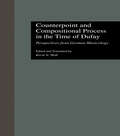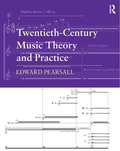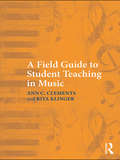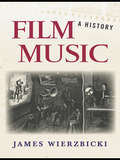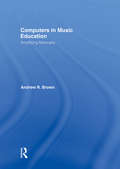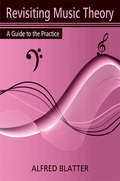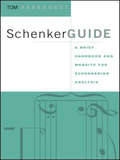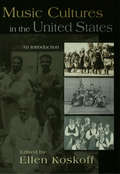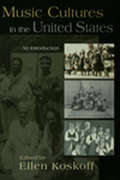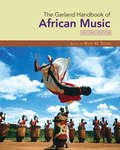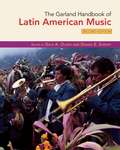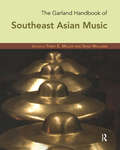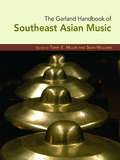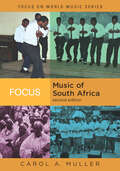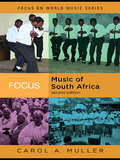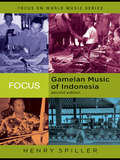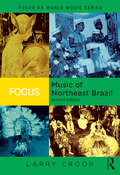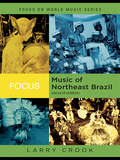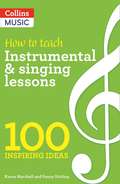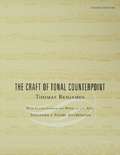- Table View
- List View
Counterpoint and Compositional Process in the Time of Dufay: Perspectives from German Musicology
by Kevin N. MollFirst Published in 1998. Routledge is an imprint of Taylor & Francis, an informa company.
Twentieth-Century Music Theory and Practice
by Edward PearsallTwentieth-Century Music Theory and Practice introduces a number of tools for analyzing a wide range of twentieth-century musical styles and genres. It includes discussions of harmony, scales, rhythm, contour, post-tonal music, set theory, the twelve-tone method, and modernism. Recent developments involving atonal voice leading, K-nets, nonlinearity, and neo-Reimannian transformations are also engaged. While many of the theoretical tools for analyzing twentieth century music have been devised to analyze atonal music, they may also provide insight into a much broader array of styles. This text capitalizes on this idea by using the theoretical devices associated with atonality to explore music inclusive of a large number of schools and contains examples by such stylistically diverse composers as Paul Hindemith, George Crumb, Ellen Taffe Zwilich, Steve Reich, Michael Torke, Philip Glass, Alexander Scriabin, Ernest Bloch, Igor Stravinsky, Béla Bartók, Sergei Prokofiev, Arnold Schoenberg, Claude Debussy, György Ligeti, and Leonard Bernstein. This textbook also provides a number of analytical, compositional, and written exercises. The aural skills supplement and online aural skills trainer on the companion website allow students to use theoretical concepts as the foundation for analytical listening.Access additional resources and online material here: http://www.twentiethcenturymusictheoryandpractice.net and https://www.motivichearing.com/.
Twentieth-Century Music Theory and Practice
by Edward PearsallTwentieth-Century Music Theory and Practice introduces a number of tools for analyzing a wide range of twentieth-century musical styles and genres. It includes discussions of harmony, scales, rhythm, contour, post-tonal music, set theory, the twelve-tone method, and modernism. Recent developments involving atonal voice leading, K-nets, nonlinearity, and neo-Reimannian transformations are also engaged. While many of the theoretical tools for analyzing twentieth century music have been devised to analyze atonal music, they may also provide insight into a much broader array of styles. This text capitalizes on this idea by using the theoretical devices associated with atonality to explore music inclusive of a large number of schools and contains examples by such stylistically diverse composers as Paul Hindemith, George Crumb, Ellen Taffe Zwilich, Steve Reich, Michael Torke, Philip Glass, Alexander Scriabin, Ernest Bloch, Igor Stravinsky, Béla Bartók, Sergei Prokofiev, Arnold Schoenberg, Claude Debussy, György Ligeti, and Leonard Bernstein. This textbook also provides a number of analytical, compositional, and written exercises. The aural skills supplement and online aural skills trainer on the companion website allow students to use theoretical concepts as the foundation for analytical listening.Access additional resources and online material here: http://www.twentiethcenturymusictheoryandpractice.net and https://www.motivichearing.com/.
A Field Guide to Student Teaching in Music
by Ann C. Clements Rita KlingerA Field Guide to Student Teaching in Music is a practical guide focused on the link between music education coursework and the field-based aspects of the student teaching experience. It addresses general topics that are common to all music placements, as well as those topics that are of specific interest to the general, choral, and instrumental music classrooms. This text builds on theoretical materials typically covered in music methods courses, yet it is not specific to any one particular teaching pedagogy, making it flexible enough for use in a variety of music teaching settings. It will guide students through the student teaching process as they make the transition from student to music educator.
A Field Guide to Student Teaching in Music
by Ann C. Clements Rita KlingerA Field Guide to Student Teaching in Music is a practical guide focused on the link between music education coursework and the field-based aspects of the student teaching experience. It addresses general topics that are common to all music placements, as well as those topics that are of specific interest to the general, choral, and instrumental music classrooms. This text builds on theoretical materials typically covered in music methods courses, yet it is not specific to any one particular teaching pedagogy, making it flexible enough for use in a variety of music teaching settings. It will guide students through the student teaching process as they make the transition from student to music educator.
Film Music: A History
by James WierzbickiFilm Music: A History explains the development of film music by considering large-scale aesthetic trends and structural developments alongside socioeconomic, technological, cultural, and philosophical circumstances. The book’s four large parts are given over to Music and the "Silent" Film (1894--1927), Music and the Early Sound Film (1895--1933), Music in the "Classical-Style" Hollywood Film (1933--1960), and Film Music in the Post-Classic Period (1958--2008). Whereas most treatments of the subject are simply chronicles of "great film scores" and their composers, this book offers a genuine history of film music in terms of societal changes and technological and economic developments within the film industry. Instead of celebrating film-music masterpieces, it deals—logically and thoroughly—with the complex ‘machine’ whose smooth running allowed those occasional masterpieces to happen and whose periodic adjustments prompted the large-scale twists and turns in film music’s path.
Computers in Music Education: Amplifying Musicality
by Andrew BrownComputers in Music Education addresses the question of how computer technologies might best assist music education. For current and preservice music teachers and designed as a development tool, reference resource, and basic teaching text, it addresses pedagogical issues and the use of computers to aid production and presentation of students’ musical works. Written by a music educator and digital media specialist, it cuts through the jargon to present a concise, easy-to-digest overview of the field, covering: notation software MIDI sound creation downloading music posting personal MP3s for mass distribution. While there are many more technical books, few offer a comprehensive, understandable overview of the field. Computers in Music Education is an important text for the growing number of courses in this area.
Computers in Music Education: Amplifying Musicality
by Andrew BrownComputers in Music Education addresses the question of how computer technologies might best assist music education. For current and preservice music teachers and designed as a development tool, reference resource, and basic teaching text, it addresses pedagogical issues and the use of computers to aid production and presentation of students’ musical works. Written by a music educator and digital media specialist, it cuts through the jargon to present a concise, easy-to-digest overview of the field, covering: notation software MIDI sound creation downloading music posting personal MP3s for mass distribution. While there are many more technical books, few offer a comprehensive, understandable overview of the field. Computers in Music Education is an important text for the growing number of courses in this area.
Revisiting Music Theory: A Guide to the Practice
by Alfred BlatterRevisiting Music Theory: A Guide to the Practice contains the basics of music theory with the vocabulary used in harmonic and formal analysis. The book assumes few music reading skills, and progresses to include the basic materials of music from J. S. Bach to the twentieth century. Based on Blatter’s own three decades of teaching music theory, this book is aimed at a one or two year introductory course in music theory, can serve for individual study, or as a review for graduate students returning to school. Drawing examples from well-known classical works, as well as folk and popular music, the book shows how theory is applied to practice. The book is divided into five parts. The first part introduces music notation, reviewing the basics of pitch, time, and dynamics as represented in written music. Part 2 introduces the concept of melody, covering modes, scales, scale degrees, and melodic form. Part 3 introduces harmony, dealing with harmonic progression, rhythm, and chord types. Part 4 addresses part writing and harmonic analysis. Finally, Part 5 addresses musical form, and how form is used to structure a composition. Revisiting Music Theory will be a valuable textbook for students, professors, and professionals.
Revisiting Music Theory: A Guide to the Practice
by Alfred BlatterRevisiting Music Theory: A Guide to the Practice contains the basics of music theory with the vocabulary used in harmonic and formal analysis. The book assumes few music reading skills, and progresses to include the basic materials of music from J. S. Bach to the twentieth century. Based on Blatter’s own three decades of teaching music theory, this book is aimed at a one or two year introductory course in music theory, can serve for individual study, or as a review for graduate students returning to school. Drawing examples from well-known classical works, as well as folk and popular music, the book shows how theory is applied to practice. The book is divided into five parts. The first part introduces music notation, reviewing the basics of pitch, time, and dynamics as represented in written music. Part 2 introduces the concept of melody, covering modes, scales, scale degrees, and melodic form. Part 3 introduces harmony, dealing with harmonic progression, rhythm, and chord types. Part 4 addresses part writing and harmonic analysis. Finally, Part 5 addresses musical form, and how form is used to structure a composition. Revisiting Music Theory will be a valuable textbook for students, professors, and professionals.
SchenkerGUIDE: A Brief Handbook and Website for Schenkerian Analysis
by Thomas PankhurstSchenkerGUIDE is an accessible overview of Heinrich Schenker's complex but fascinating approach to the analysis of tonal music. The book has emerged out of the widely used website, www.SchenkerGUIDE.com, which has been offering straightforward explanations of Schenkerian analysis to undergraduate students since 2001. Divided into four parts, SchenkerGUIDE offers a step-by-step method to tackling this often difficult system of analysis. Part I is an introduction to Schenkerian analysis, outlining the concepts that are involved in analysis Part II outlines a unique and detailed working method to help students to get started on the process of analysis Part III puts some of these ideas into practice by exploring the basics of a Schenkerian approach to form, register, motives and dramatic structure Part IV provides a series of exercises from the simple to the more sophisticated, along with hints and tips for their completion.
SchenkerGUIDE: A Brief Handbook and Website for Schenkerian Analysis
by Thomas PankhurstSchenkerGUIDE is an accessible overview of Heinrich Schenker's complex but fascinating approach to the analysis of tonal music. The book has emerged out of the widely used website, www.SchenkerGUIDE.com, which has been offering straightforward explanations of Schenkerian analysis to undergraduate students since 2001. Divided into four parts, SchenkerGUIDE offers a step-by-step method to tackling this often difficult system of analysis. Part I is an introduction to Schenkerian analysis, outlining the concepts that are involved in analysis Part II outlines a unique and detailed working method to help students to get started on the process of analysis Part III puts some of these ideas into practice by exploring the basics of a Schenkerian approach to form, register, motives and dramatic structure Part IV provides a series of exercises from the simple to the more sophisticated, along with hints and tips for their completion.
Music Cultures in the United States: An Introduction
by Ellen KoskoffMusic Cultures in the United States is a basic textbook for an Introduction to American Music course. Taking a new, fresh approach to the study of American music, it is divided into three parts. In the first part, historical, social, and cultural issues are discussed, including how music history is studied; issues of musical and social identity; and institutions and processes affecting music in the U.S. The heart of the book is devoted to American musical cultures: American Indian; European; African American; Latin American; and Asian American. Each cultural section has a basic introductory article, followed by case studies of specific musical cultures. Finally, global musics are addressed, including Classical Musics and Popular Musics, as they have been performed in the U.S..Each article is written by an expert in the field, offering in-depth, knowledgeable, yet accessible writing for the student. The accompanying CD offers musical examples tied to each article. Pedagogic material includes chapter overviews, questions for study, and a chronoloogy of key musical events in American music and definitions in the margins.
Music Cultures in the United States: An Introduction
by Ellen KoskoffMusic Cultures in the United States is a basic textbook for an Introduction to American Music course. Taking a new, fresh approach to the study of American music, it is divided into three parts. In the first part, historical, social, and cultural issues are discussed, including how music history is studied; issues of musical and social identity; and institutions and processes affecting music in the U.S. The heart of the book is devoted to American musical cultures: American Indian; European; African American; Latin American; and Asian American. Each cultural section has a basic introductory article, followed by case studies of specific musical cultures. Finally, global musics are addressed, including Classical Musics and Popular Musics, as they have been performed in the U.S..Each article is written by an expert in the field, offering in-depth, knowledgeable, yet accessible writing for the student. The accompanying CD offers musical examples tied to each article. Pedagogic material includes chapter overviews, questions for study, and a chronoloogy of key musical events in American music and definitions in the margins.
The Garland Handbook of African Music
by Ruth M. StoneThe Garland Handbook of African Music is comprised of essays from The Garland Encyclopedia of World Music: Volume 1, Africa, (1997). Revised and updated, the essays offer detailed, regional studies of the different musical cultures of Africa and examine the ways in which music helps to define the identity of this particular area. Part One provides an in-depth introduction to Africa. Part Two focuses on issues and processes, such as notation and oral tradition, dance in communal life, and intellectual property. Part Three focuses on the different regions, countries, and cultures of Africa with selected regional case studies. The second edition has been expanded to include exciting new scholarship that has been conducted since the first edition was published. Questions for Critical Thinking at the end of each major section guide and focus attention on what musical and cultural issues arise when one studies the music of Africa -- issues that might not occur in the study of other musics of the world. An accompanying audio compact disc offers musical examples of some of the music of Africa.
The Garland Handbook of Latin American Music
by Dale Olsen Daniel SheehyThe Garland Handbook of Latin American Music is comprised of essays from The Garland Encyclopedia of World Music: Volume 2, South America, Mexico, Central America, and the Carribean, (1998). Revised and updated, the essays offer detailed, regional studies of the different musical cultures of Latin America and examine the ways in which music helps to define the identity of this particular area. Part One provides an in-depth introduction to the area of Latin America and describes the history, geography, demography, and cultural settings of the regions that comprise Latin America. It also explores the many ways to research Latin American music, including archaeology, iconography, mythology, history, ethnography, and practice. Part Two focuses on issues and processes, such as history, politics, geography, and immigration, which are responsible for the similarities and the differences of each region’s uniqueness and individuality. Part Three focuses on the different regions, countries, and cultures of Caribbean Latin America, Middle Latin America, and South America with selected regional case studies. The second edition has been expanded to cover Haiti, Panama, several more Amerindian musical cultures, and Afro-Peru. Questions for Critical Thinking at the end of each major section guide focus attention on what musical and cultural issues arise when one studies the music of Latin America -- issues that might not occur in the study of other musics of the world. Two audio compact discs offer musical examples of some of the music of Latin America.
The Garland Handbook of Southeast Asian Music
by Terry Miller Sean WilliamsThe Garland Handbook of Southeast Asian Music is comprised of essays from The Garland Encyclopedia of World Music: Volume 4, Southeast Asia (1998). Largely revised and updated, the essays offer detailed, regional studies of the different musical cultures of Southeast Asia and examine the ways in which music helps to define the identity of this particular area. Part one provides an in-depth introduction to the area of Southeast Asia and explores a series of issues and processes, such as colonialism, mass media, spirituality, and war. The articles in this section are important in gaining historical, political, and social perspective. Part two focuses on mainland Southeast Asia, with essays representing Cambodia, Thailand, Laos, Burma, Peninsular Malaysia, Vietnam, Singapore, and the minority peoples of mainland Southeast Asia. Part three focuses on island Southeast Asia, dividing the area into three sections: Indonesia, the Philippines, and Borneo. In addition to offering a detailed study of the music of each area, it also offers recent perspectives on the gamelan and theater traditions of Indonesia. Questions for Critical Thinking at the end of each major section guide and focus attention on what issues – musical and cultural – arise when one studies the music of Southeast Asia – issues that might not occur in the study of other musics of the world. An accompanying compact disc offers musical examples from Southeast Asia.
The Garland Handbook of Southeast Asian Music
by Terry Miller Sean WilliamsThe Garland Handbook of Southeast Asian Music is comprised of essays from The Garland Encyclopedia of World Music: Volume 4, Southeast Asia (1998). Largely revised and updated, the essays offer detailed, regional studies of the different musical cultures of Southeast Asia and examine the ways in which music helps to define the identity of this particular area. Part one provides an in-depth introduction to the area of Southeast Asia and explores a series of issues and processes, such as colonialism, mass media, spirituality, and war. The articles in this section are important in gaining historical, political, and social perspective. Part two focuses on mainland Southeast Asia, with essays representing Cambodia, Thailand, Laos, Burma, Peninsular Malaysia, Vietnam, Singapore, and the minority peoples of mainland Southeast Asia. Part three focuses on island Southeast Asia, dividing the area into three sections: Indonesia, the Philippines, and Borneo. In addition to offering a detailed study of the music of each area, it also offers recent perspectives on the gamelan and theater traditions of Indonesia. Questions for Critical Thinking at the end of each major section guide and focus attention on what issues – musical and cultural – arise when one studies the music of Southeast Asia – issues that might not occur in the study of other musics of the world. An accompanying compact disc offers musical examples from Southeast Asia.
Focus: Music of South Africa
by Carol A. MullerFocus: Music of South Africa provides an in-depth look at the full spectrum of South African music, a musical culture that epitomizes the enormous ethnic, religious, linguistic, class, and gender diversity of the nation itself. Drawing on extensive field and archival research, as well as her own personal experiences, noted ethnomusicologist and South African native Carol A. Muller looks at how South Africans have used music to express a sense of place in South Africa, on the African continent, and around the world. Part One, Creating Connections, provides introductory materials for the study of South African Music. Part Two, Musical Migrations, moves to a more focused overview of significant musical styles in twentieth-century South Africa -- particularly those known through world circuits. Part Three, Focusing In, takes the reader into the heart of two musical cultures with case studies on South African jazz and the music of the Zulu-language followers of Isaiah Shembe. The accompanying CD offers vivid examples of traditional, popular, and classical South African musical styles.
Focus: Music of South Africa
by Carol A. MullerFocus: Music of South Africa provides an in-depth look at the full spectrum of South African music, a musical culture that epitomizes the enormous ethnic, religious, linguistic, class, and gender diversity of the nation itself. Drawing on extensive field and archival research, as well as her own personal experiences, noted ethnomusicologist and South African native Carol A. Muller looks at how South Africans have used music to express a sense of place in South Africa, on the African continent, and around the world. Part One, Creating Connections, provides introductory materials for the study of South African Music. Part Two, Musical Migrations, moves to a more focused overview of significant musical styles in twentieth-century South Africa -- particularly those known through world circuits. Part Three, Focusing In, takes the reader into the heart of two musical cultures with case studies on South African jazz and the music of the Zulu-language followers of Isaiah Shembe. The accompanying CD offers vivid examples of traditional, popular, and classical South African musical styles.
Focus: Gamelan Music of Indonesia (Focus on World Music Series)
by Henry SpillerFocus: Gamelan Music of Indonesia is an introduction to the familiar music from Southeast Asia's largest country - both as sound and cultural phenomenon. An archipelago of over 17,000 islands, Indonesia is a melting pot of Hindu, Buddhist, Islamic, Portuguese, Dutch, and British influences. Despite this diversity, it has forged a national culture, one in which music plays a significant role. Gamelan music, in particular, teaches us much about Indonesian values and modern-day life. Focus: Gamelan Music of Indonesia provides an introduction to present-day Javanese, Balinese, Cirebonese, and Sundanese gamelan music through ethnic, social, cultural, and global perspectives. Part One, Music and Southeast Asian History¸ provides introductory materials for the study of Southeast Asian music. Part Two, Gamelan Music in Java and Bali, moves to a more focused overview of Gamelan music in Indonesia. Part Three, Focusing In, takes an in-depth look at Sundanese gamelan traditions, as well modern developments in Sundanese music and dance. The accompanying CD offers vivid examples of traditional Indonesian gamelan music.
Focus: Music of Northeast Brazil
by Larry CrookFocus: Music of Northeast Brazil examines the historical and contemporary manifestations of the music of Brazil, a country with a musical landscape that is layered with complexity and diversity. Based on the author’s field research during the past twenty years, the book describes and analyzes the social/historical contexts and contemporary musical practices of Afro-Brazilian religion, selected Carnival traditions, Bahia’s black cultural renaissance, the traditions of rural migrants, and currents in new popular music. Part One, Understanding Music in Brazil, presents important issues and topics that encompass all of Brazil, and provides a general survey of Brazil’s diverse musical landscape. Part Two, Creating Music in Brazil, presents historical trajectories and contemporary examples of Afro-Brazilian traditions, Carnival music, and northeastern popular music. Part Three, Focusing In, presents two case studies that explore the ground-level activities of contemporary musicians in Northeast Brazil and the ways in which they move between local, national, and international realms. The accompanying CD offers vivid musical examples that are discussed in the text
Focus: Music of Northeast Brazil
by Larry CrookFocus: Music of Northeast Brazil examines the historical and contemporary manifestations of the music of Brazil, a country with a musical landscape that is layered with complexity and diversity. Based on the author’s field research during the past twenty years, the book describes and analyzes the social/historical contexts and contemporary musical practices of Afro-Brazilian religion, selected Carnival traditions, Bahia’s black cultural renaissance, the traditions of rural migrants, and currents in new popular music. Part One, Understanding Music in Brazil, presents important issues and topics that encompass all of Brazil, and provides a general survey of Brazil’s diverse musical landscape. Part Two, Creating Music in Brazil, presents historical trajectories and contemporary examples of Afro-Brazilian traditions, Carnival music, and northeastern popular music. Part Three, Focusing In, presents two case studies that explore the ground-level activities of contemporary musicians in Northeast Brazil and the ways in which they move between local, national, and international realms. The accompanying CD offers vivid musical examples that are discussed in the text
100 Ideas For Music: Instrumental And Singing Teaching (PDF)
by A C A C BlackHow to teach Instrumental and Singing lessons presents 100 diverse ideas for teachers of every instrument. The ideas are concise, easy to implement and tackle everything from scales, sight-reading and performance anxiety to group teaching, special needs and business practicalities. This practical handbook will invigorate lessons with any pupil.
The Craft of Tonal Counterpoint
by Thomas BenjaminFirst Published in 2003. Routledge is an imprint of Taylor & Francis, an informa company.
